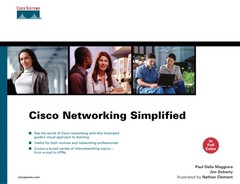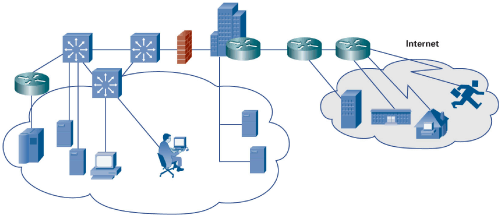Identity is the identification of network users, hosts, applications, services, and resources. Examples of technologies that enable identification include Remote Authentication Dial-In User Service (RADIUS), Kerberos, one-time passwords, digital certificates, smart cards, and directory services.
Perimeter security ontrols access to critical network applications, data, and services so that only legitimate users and information can access these assets. Examples include access lists on routers and switches, firewalls, virus scanners, and content filters.
The ability to provide secure communication is crucial when you must protect information from eavesdropping. Digital encryption technologies and protocols such as Internet Protocol Security (IPSec) are the primary means for protecting data, especially when implementing virtual private networks (VPNs).
Regardless of how security is implemented, it is still necessary to monitor a network and its components to ensure that the network remains secure. Network-security monitoring tools and intrusion detection systems (IDSs) provide visibility to the security status of the network.
Tools and technologies are worthless without well-defined security policies. Effective policies balance the imposition of security measures against the productivity gains realized with little security. Centralized policy-management tools that can analyze, interpret, configure, and monitor the state of security policies help consolidate the successful deployment of rational security policies.
A company’s network is like any other corporate asset: It is valuable to the success and revenue of that company. More than ever, the corporate computer network is the most valuable asset of many companies. Therefore, it must be protected. Generally, middle- to large-size companies appoint a chief security officer, whose job is to develop and enforce corporate security policies.
Security threats present themselves in many forms:
A hacker breaking into the network to steal confidential information or destroy corporate data
A natural disaster such as a fire, tornado, or earthquake destroying computer and network equipment
A disgruntled employee intentionally trying to modify, steal, or destroy corporate information and devices
A computer virus
An act of war or terrorism
Common security threats introduced by people include the following:
Network packet sniffers
IP spoofing
Password attacks
Distribution of sensitive internal information to external sources
Man-in-the-middle attacks
Internet security is also a big concern given the exposure of corporate data resources to the publicly accessible Internet. Traditionally, you could achieve security by physically separating corporate networks from public networks. However, with corporate web servers and databases—and the desire to provide access to corporate resources to employees over the Internet—companies must be especially diligent in protecting their networks.
Another recent area for security concern is wireless networking. Traditional networking occurred over physical wires or fibers. However, the current trend is to provide networking services over radio frequencies. Companies are installing wireless networking in their buildings so employees can link to the corporate network from conference rooms and other shared locations from their laptop computers. Additionally, service providers are now offering public wireless Internet services.
You can define identity terms of authentication and authorization:
A computer or computer user identifies itself to the network or network resources.
Authorization occurs after authentication. After the computer or user successfully identifies itself, the network or server authorizes the individual or computer to perform certain things with a certain level of access.
802.1x is a link layer protocol used for transporting higher-level authentication protocols defined by the Institute of Electrical and Electronic Engineers (IEEE).
One form of authentication occurs through the exchange of passwords. This form is generally a one-way transaction in which a user or computer identifies itself to a network or server.
A popular method for securely identifying a machine or individual uses digital signatures. For example, if you send an e-mail to someone, he might want to verify that you were indeed the originator of the e-mail. Algorithms such as Secure Hash Algorithm (SHA), Message Digest 5 (MD5) (similar to checksum), and triple Digital Encryption Standard (3DES) encrypt and securely “sign” the message. Then, the sender and receiver match public and private keys. The combination of these methods allows both parties to trust (or not trust) each other when exchanging information.










